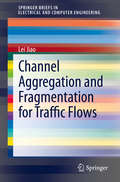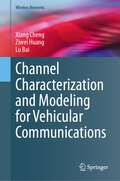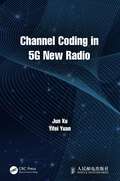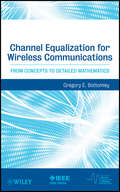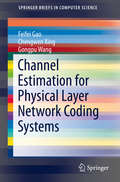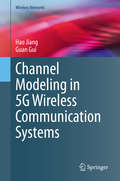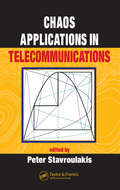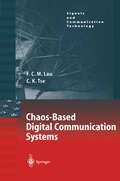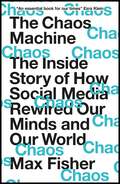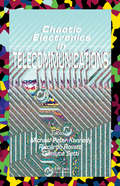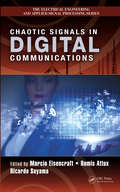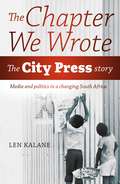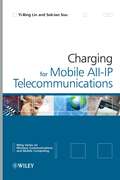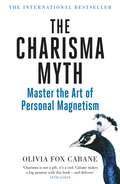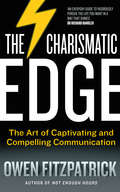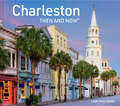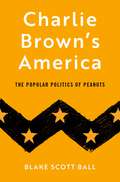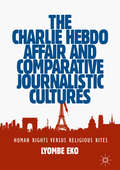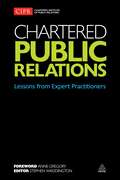- Table View
- List View
Channel Aggregation and Fragmentation for Traffic Flows (SpringerBriefs in Electrical and Computer Engineering)
by Lei JiaoThis book introduces the impact of channel aggregation (CA) and channel fragmentation (CF) on traffic flows, through analytical models, computer simulations, and test-bed implementations. Its content includes the concept of CA and CF, the basic concept and calculation of Markov chains (MCs), the modeling process of the CA and CF enabled system via MCs, the process of simulations, and a test-bed study based on a software defined radio.This book can serve as a study guide for advanced-level students, who are interested in studying the impact of CA and CF techniques on traffic flows. This book would also interest communication engineers, who would like to learn MC modeling for performance evaluations, as it includes a step-by-step guidance for the modeling process via MCs, as well as its simulation approaches.
Channel Characterization and Modeling for Vehicular Communications (Wireless Networks)
by Xiang Cheng Ziwei Huang Lu BaiThis book presents and develops comprehensive knowledge of vehicular channel characteristics and proper vehicular channel models. The studied topics contain the propagation characteristics of vehicular communications, such as: a time-frequency non-stationary single-input single-output (SISO) vehicle-to-vehicle (V2V) non-geometry stochastic model (NGSM); a space-time non-stationary massive multiple-input multiple-output (MIMO) V2V regular-shaped geometry-based stochastic model (RS-GBSM); and a space-time non-stationary massive MIMO V2V irregular-shaped geometry-based stochastic model (IS-GBSM). Each is introduced, with characteristics then discussed in detail. Finally, this book discusses future research directions to inspire further investigation in the field of vehicular channels from three different perspectives.
Channel Coding in 5G New Radio
by Jun Xu Yifei YuanThis book provides a comprehensive coverage of major channel codes adopted since the 3rd generation of mobile communication. Modulation schemes suitable for 5G mobile communications are also described based on key New Radio application scenarios and performance requirements. It covers low density parity check (LDPC) codes, Polar codes, tail-biting convolutional codes (TBCC) and Turbo codes. Outer codes and a few advanced coding and modulations are also discussed. In addition, it includes detailed illustration of each channel coding scheme such as the basic code structure, decoding algorithms, performance evaluation and complexity analysis. The book offers insights on why and how channel codes are designed and developed in standardization organizations, which significantly facilitates the reading and understanding of the of 5G channel coding technologies. Channel Coding in 5G New Radio will be an essential read for researchers and students of digital communications, wireless communications engineers, and those who are interested in mobile communications in general.
Channel Coding in 5G New Radio
by Jun Xu Yifei YuanThis book provides a comprehensive coverage of major channel codes adopted since the 3rd generation of mobile communication. Modulation schemes suitable for 5G mobile communications are also described based on key New Radio application scenarios and performance requirements. It covers low density parity check (LDPC) codes, Polar codes, tail-biting convolutional codes (TBCC) and Turbo codes. Outer codes and a few advanced coding and modulations are also discussed. In addition, it includes detailed illustration of each channel coding scheme such as the basic code structure, decoding algorithms, performance evaluation and complexity analysis. The book offers insights on why and how channel codes are designed and developed in standardization organizations, which significantly facilitates the reading and understanding of the of 5G channel coding technologies. Channel Coding in 5G New Radio will be an essential read for researchers and students of digital communications, wireless communications engineers, and those who are interested in mobile communications in general.
Channel Equalization for Wireless Communications: From Concepts to Detailed Mathematics (IEEE Series on Digital & Mobile Communication #20)
by Gregory E. BottomleyThe most thorough, up-to-date reference on channel equalization—from basic concepts to complex modeling techniques In today's instant-access society, a high premium is placed on information that can be stored and communicated effectively. As a result, storage densities and communications rates are being pushed to capacity, causing information symbols to interfere with one another. To help unclog pathways for the clearer conveyance of information, this book offers in-depth discussion of the significant contributions and future adaptability of channel equalization and a set of approaches for solving the problem of intersymbol interference (ISI). Chapter explorations in Channel Equalization include: Channel equalization topics presented with incremental learning methodology—from the very fundamental concept to more advanced mathematical knowledge Coverage of technology used in second-, third- and fourth-generation cellular communication systems A set of homework problems that reinforce concepts discussed in the book Tutorial explanations of recent developments currently captured in IEEE technical journals Unlike existing digital communications books that devote cursory attention to channel equalization, this invaluable guide addresses a crucial need by focusing solely on the background, current state, and future direction of this increasingly important technology. A unique mix of basic concepts and complex frameworks for delivering digitized data make Channel Equalization a valuable reference for all practicing wireless communication engineers and students dealing with the pressing demands of the information age.
Channel Equalization for Wireless Communications: From Concepts to Detailed Mathematics (IEEE Series on Digital & Mobile Communication #20)
by Gregory E. BottomleyThe most thorough, up-to-date reference on channel equalization—from basic concepts to complex modeling techniques In today's instant-access society, a high premium is placed on information that can be stored and communicated effectively. As a result, storage densities and communications rates are being pushed to capacity, causing information symbols to interfere with one another. To help unclog pathways for the clearer conveyance of information, this book offers in-depth discussion of the significant contributions and future adaptability of channel equalization and a set of approaches for solving the problem of intersymbol interference (ISI). Chapter explorations in Channel Equalization include: Channel equalization topics presented with incremental learning methodology—from the very fundamental concept to more advanced mathematical knowledge Coverage of technology used in second-, third- and fourth-generation cellular communication systems A set of homework problems that reinforce concepts discussed in the book Tutorial explanations of recent developments currently captured in IEEE technical journals Unlike existing digital communications books that devote cursory attention to channel equalization, this invaluable guide addresses a crucial need by focusing solely on the background, current state, and future direction of this increasingly important technology. A unique mix of basic concepts and complex frameworks for delivering digitized data make Channel Equalization a valuable reference for all practicing wireless communication engineers and students dealing with the pressing demands of the information age.
Channel Estimation for Physical Layer Network Coding Systems (SpringerBriefs in Computer Science)
by Feifei Gao Chengwen Xing Gongpu WangThis SpringerBrief presents channel estimation strategies for the physical later network coding (PLNC) systems. Along with a review of PLNC architectures, this brief examines new challenges brought by the special structure of bi-directional two-hop transmissions that are different from the traditional point-to-point systems and unidirectional relay systems. The authors discuss the channel estimation strategies over typical fading scenarios, including frequency flat fading, frequency selective fading and time selective fading, as well as future research directions. Chapters explore the performance of the channel estimation strategy and optimal structure of training sequences for each scenario. Besides the analysis of channel estimation strategies, the book also points out the necessity of revisiting other signal processing issues for the PLNC system. Channel Estimation of Physical Layer Network Coding Systems is a valuable resource for researchers and professionals working in wireless communications and networks. Advanced-level students studying computer science and electrical engineering will also find the content helpful.
Channel Modeling in 5G Wireless Communication Systems (Wireless Networks)
by Hao Jiang Guan GuiThis book addresses the fundamental design and technical challenges for fifth generation (5G) wireless channel models, including multi-frequency bands and multi-scenarios. The book presents a strong vision for 5G wireless communication networks based on current market trends, proven technologies, and future directions. The book helps enable researchers and industry professionals to come up with novel ideas in the area of wireless heterogeneity, to minimize traffic accidents, to improve traffic efficiency, and to foster the development of new applications such as mobile infotainment. The book acts as a comprehensive reference for students, instructors, researchers, engineers, and other professionals, building their understanding of 5G and in designing 5G systems.Addresses fundamental design and technical challenges for 5G wireless channel models;Presents how to create reliable statistical channel models to capture the propagation properties between transmitters and receivers;Pertinent to researchers, engineers, and professionals in 5G.
Chaos Applications in Telecommunications
by Peter StavroulakisThe concept of transmitting information from one chaotic system to another derives from the observation of the synchronization of two chaotic systems. Having developed two chaotic systems that can be synchronized, scientists can modulate on one phase signal the information to be transmitted, and subtract (demodulate) the information from the corres
Chaos-Based Digital Communication Systems: Operating Principles, Analysis Methods, and Performance Evaluation (Signals and Communication Technology)
by Francis C.M. Lau Chi K. TseOne of the first books in this area, this text focuses on important aspects of the system operation, analysis and performance evaluation of selected chaos-based digital communications systems – a hot topic in communications and signal processing.
The Chaos Machine: The Inside Story of How Social Media Rewired Our Minds and Our World
by Max FisherThe Chaos Machine is an essential book for our times - Ezra KleinThe Chaos Machine is the story of how the world was driven mad by social media. The election of populists like Trump and Bolsonaro; strife and genocide in countries like Myanmar; the rampant spread of COVID-19 conspiracy theories as deadly as the pandemic itself; all of these are products of a breakdown in our social and political lives, a breakdown driven by the apps, companies and algorithms that compete constantly for our attention.Max Fisher is a leading New York Times technology reporter whose work has covered the way that social media sites - driven increasingly by artificial intelligence rather than human ingenuity - push users towards more and more extreme positions, deepening the divisions in society in pursuit of greater engagement and profit. With extraordinary access to the most powerful players in Silicon Valley, and with testimonies from around the world of the havoc being wreaked by our online selves, The Chaos Machine shows us how we got to this uniquely perilous moment - and how we might get out of it.
Chaotic Electronics in Telecommunications
by Michael Kennedy Riccardo Rovatti Gianluca SettiAt the code level, discrete-time chaotic systems can be used to generate spreading codes for DS-SS systems. At the signal level, continuous-time chaotic systems can be used to generate wideband carriers for digital modulation schemes.The potential of chaos engineering is now recognized worldwide, with research groups actively pursuing the exploitation of chaotic phenomena in cryptography, spread spectrum communications, electromagnetic interference reduction, and many other applications. Although some noteworthy results have already been achieved, until now, the field has lacked both a systematic treatment of these developments and a careful, quantitative comparison of chaos-based and conventional techniques.Chaotic Electronics in Telecommunications fills both of those needs. It addresses the use of chaos in digital communications applications, from the coding level to circuit design. Each chapter offers a formal exposition of the theoretical and engineering tools needed to apply chaos, followed by discussion of the algorithms and circuits needed to apply the theory to real-world communications systems.
Chaotic Electronics in Telecommunications
by M.P. Kennedy, R. Rovatti and G. SettiAt the code level, discrete-time chaotic systems can be used to generate spreading codes for DS-SS systems. At the signal level, continuous-time chaotic systems can be used to generate wideband carriers for digital modulation schemes.The potential of chaos engineering is now recognized worldwide, with research groups actively pursuing the exploitation of chaotic phenomena in cryptography, spread spectrum communications, electromagnetic interference reduction, and many other applications. Although some noteworthy results have already been achieved, until now, the field has lacked both a systematic treatment of these developments and a careful, quantitative comparison of chaos-based and conventional techniques.Chaotic Electronics in Telecommunications fills both of those needs. It addresses the use of chaos in digital communications applications, from the coding level to circuit design. Each chapter offers a formal exposition of the theoretical and engineering tools needed to apply chaos, followed by discussion of the algorithms and circuits needed to apply the theory to real-world communications systems.
Chaotic Signals in Digital Communications (Electrical Engineering & Applied Signal Processing Series)
by Marcio Eisencraft Romis Attux Ricardo SuyamaChaotic Signals in Digital Communications combines fundamental background knowledge with state-of-the-art methods for using chaotic signals and systems in digital communications. The book builds a bridge between theoretical works and practical implementation to help researchers attain consistent performance in realistic environments. It shows the possible shortcomings of the chaos-based communication systems proposed in the literature, particularly when they are subjected to non-ideal conditions. It also presents a toolbox of techniques for researchers working to actually implement such systems. A Combination of Tutorials and In-Depth, Cutting-Edge Research Featuring contributions by active leading researchers, the book begins with an introduction to communication theory, dynamical systems, and chaotic communications suitable for those new to the field. This lays a solid foundation for the more applied chapters that follow. A Toolbox of Techniques—Including New Ways to Tackle Channel Imperfections The book covers typical chaos communication methods, namely chaotic masking, chaotic modulation, chaotic shift key, and symbolic message bearing, as well as bidirectional communication and secure communication. It also presents novel methodologies to deal with communication channel imperfections. These tackle band-limited channel chaos communication, radio channels with fading, and the resistance of a special chaotic signal to multipath propagations. In addition, the book addresses topics related to engineering applications, such as optical communications, chaotic matched filters and circuit implementations, and microwave frequency-modulated differential chaos shift keying (FM-DCSK) systems. Insights for Both Theoretical and Experimental Researchers Combining theory and practice, this book offers a unique perspective on chaotic communication in the context of non-ideal conditions. Written for theoretical and experimental researchers, it tackles the practical issues faced in implementing chaos-based signals and systems in digital communications applications.
Chaotic Signals in Digital Communications (Electrical Engineering & Applied Signal Processing Series)
by Marcio Eisencraft, Romis Attux and Ricardo SuyamaChaotic Signals in Digital Communications combines fundamental background knowledge with state-of-the-art methods for using chaotic signals and systems in digital communications. The book builds a bridge between theoretical works and practical implementation to help researchers attain consistent performance in realistic environments. It shows the possible shortcomings of the chaos-based communication systems proposed in the literature, particularly when they are subjected to non-ideal conditions. It also presents a toolbox of techniques for researchers working to actually implement such systems. A Combination of Tutorials and In-Depth, Cutting-Edge Research Featuring contributions by active leading researchers, the book begins with an introduction to communication theory, dynamical systems, and chaotic communications suitable for those new to the field. This lays a solid foundation for the more applied chapters that follow. A Toolbox of Techniques—Including New Ways to Tackle Channel Imperfections The book covers typical chaos communication methods, namely chaotic masking, chaotic modulation, chaotic shift key, and symbolic message bearing, as well as bidirectional communication and secure communication. It also presents novel methodologies to deal with communication channel imperfections. These tackle band-limited channel chaos communication, radio channels with fading, and the resistance of a special chaotic signal to multipath propagations. In addition, the book addresses topics related to engineering applications, such as optical communications, chaotic matched filters and circuit implementations, and microwave frequency-modulated differential chaos shift keying (FM-DCSK) systems. Insights for Both Theoretical and Experimental Researchers Combining theory and practice, this book offers a unique perspective on chaotic communication in the context of non-ideal conditions. Written for theoretical and experimental researchers, it tackles the practical issues faced in implementing chaos-based signals and systems in digital communications applications.
The Chapter we Wrote: The City Press Story
by Len KalaneIn The Chapter We Wrote, Len Kalane, former editor of the newspaper, tells not only the story of City Press, but also a tale of the stories and events that shaped contemporary South Africa. Kalane traces the birth of City Press in the 1950s and the early days of the newspaper, along with its iconic sister publication, Drum magazine. He details the role that Naspers, who bought the paper in the 1980s, and the erstwhile apartheid communication machinery played behind the scenes in an attempt to reconcile two constituencies – Afrikaner and black nationalist – and to move South Africa out of its political conundrum and towards a negotiated, peaceful settlement.The book is in memory of author and journalist Percy Qoboza, and also incorporates a selection of his columns. It brings vividly to life the newsrooms of an iconic South African brand, and will be useful to students, academics and the interested lay reader.
Charging for Mobile All-IP Telecommunications (Wireless Communications and Mobile Computing #7)
by Yi-Bing Lin Sok-Ian SouThis book provides a complete and comprehensive overview of 3G UMTS charging services Evolving from offline billing of traditional telecommunications, charging for IP services in mobile networks is challenging; charging convergence is one of the major trends in the telecom industry. Advanced mobile telecommunications incorporates data applications with real-time control and management, and requires a convergent and flexible online charging system. Such convergence is essential to mitigate fraud and credit risks in order to provide more personalized information to users about charges and credit limit controls. Charging for Mobile All-IP Telecommunications provides comprehensive and practical coverage of online and offline charging based on mobile operator experiences, and the latest efforts undertaken by the UMTS specifications. Key features: Presents a complete overview of the telecommunications charging system, including the evolution from 2G to 3G and all-IP network charging frameworks Discusses all management aspects related to charging and billing processes, with a focus on the major trends and developments within the telecoms industry Provides an overview of the telecom networks such as PSTN, GSM, UMTS and IMS Covers the concepts of the telecom charging on mobile services and the new technologies for implementing online charging system, such as GTP’ and Diameter protocol Contains coverage on network nodes and data flows in relation to charging of mobile applications, such as IMS call and content downloading Explains the IP-based online charging system, protocol details and recent trends in charging for mobile telecom industry This book is an invaluable resource for graduate students, telecoms and IP engineers, network service providers and system architects. Information technologists and networking equipment manufacturers will also find this book insightful.
The Charisma Myth: Master the Art of Personal Magnetism
by Olivia Fox CabaneIn The Charisma Myth, Olivia Fox Cabane provides powerful advice to make absolutely anyone more charismatic.What if charisma could be taught?Charisma can be a huge asset if you're applying for a job, improving your relationships, or leading other people. The Charisma Myth shows you how to become more influential, more persuasive, and more inspiring. Soon you'll be able to move through a room and have people say: 'Wow, who's that?'Many people believe that charisma is unchangeable - you either have it or you don't. But that's simply not true. This groundbreaking, bestselling book reveals how charismatic behaviour can be learned by anyone.Olivia Fox Cabane helps some of the world's best-known people become more charismatic. Here she breaks charisma down into its fundamental components, revealing the secrets to how it works. Improving your charisma doesn't mean transforming your personality: it's about adopting a series of practices that suit you. So what are you waiting for?'Charisma is not a gift, it's a tool. Cabane makes a big promise with this book and delivers on it' -Seth Godin 'Until I encountered Olivia Fox Cabane, I'd naively believed charisma was an intangible, magical aura... around a couple of hours can transform a reasonably personable person into someone magnetic' -Sunday Telegraph'If you are interested in increasing your ability to be charismatic, this book will give you direct skills to use' -Psychology TodayOlivia Fox Cabane has lectured at Harvard, Yale, Stanford, MIT, and the United Nations. She is a frequent keynote speaker and executive coach to the leadership of Fortune 500 companies. From a base of thorough behavioural science, Cabane extracts the most practical tools for business, giving her clients techniques she originally developed for Harvard and MIT. She has been featured in media such as Forbes, The New York Times, BusinessWeek, and The Wall Street Journal. www.AskOlivia.com
The Charismatic Edge: An Everyday Guide to Developing Your Own Charisma and Compelling Communications Skills
by Owen FitzpatrickThe rules of communication are radically different than ever before. Standing out and being counted is no longer just an advantage. It is a necessity. You are your own brand and, unless you learn how to shine, you'll be left behind.Whether you are looking to get a promotion, become a better leader, master public speaking, build your business, sell more, improve your love life, social life or even your networking skills, you need to be more effective at engaging people – you need to be more effective at branding yourself and making an impact on others.Charisma is a must. And here's the good news: You can learn it.Find out:The secrets that the best speakers, screenwriters, comedians, politicians and gurus know about impacting their audience.The keys to supreme self-confidence and high self-esteem.How you can use your body, voice and energy to influence others. How to create an irresistible first impression, instantly.What only the very best business leaders, sales people, marketing executives, advertisers and world class negotiators all understand about winning the hearts and minds of their teams and customers.Charisma is often misunderstood as a quality that some people have but others don’t. In this book you’ll learn how, in reality, charisma is an impression you create in the mind of another person which can be improved and mastered by anyone, including you.
Charleston Then and Now
by null Leigh Jones HandalFollowing her success with Lost Charleston, local author and city tour guide Leigh Jones Handal brings a fresh approach to one of the key titles in Pavilion Books’ trademark series. Charleston, South Carolina is one of the most popular East Coast tourist destinations. The flashpoint of the Civil War, what remains of Fort Sumter in Charleston is still a much-visited attraction, and despite bombardment by the Federal Navy, earthquakes and many hurricanes, the South Carolina city has retained its 19th-century charm. City guide Leigh Jones Handal tells the story of the Charleston she loves through archive photos matched with their modern viewpoint, including the Jenkins Orphanage whose band were the likely originators of the Charleston dance. There are vintage photos of the great plantation houses, plus the grand buildings on Meeting Street, and the soaring spires of Charleston’s many churches. Downtown many of the classic mansions, such as the Miles Brewton House, have been retained, along with the Market Hall and the Customs House, and though the trolleys no longer run along Broad Street, it is still recognizable from a century before. Leigh Jones Handal has uncovered a treasury of vintages images which have been matched with modern photos to show new aspects of this enduringly fascinating city.
Charlie Brown's America: The Popular Politics of Peanuts
by Blake Scott BallDespite--or because of--its huge popular culture status, Peanuts enabled cartoonist Charles Schulz to offer political commentary on the most controversial topics of postwar American culture through the voices of Charlie Brown, Snoopy, and the Peanuts gang. In postwar America, there was no newspaper comic strip more recognizable than Charles Schulz's Peanuts. It was everywhere, not just in thousands of daily newspapers. For nearly fifty years, Peanuts was a mainstay of American popular culture in television, movies, and merchandising, from the Macy's Thanksgiving Day Parade to the White House to the breakfast table. Most people have come to associate Peanuts with the innocence of childhood, not the social and political turmoil of the 1960s and 1970s. Some have even argued that Peanuts was so beloved because it was apolitical. The truth, as Blake Scott Ball shows, is that Peanuts was very political. Whether it was the battles over the Vietnam War, racial integration, feminism, or the future of a nuclear world, Peanuts was a daily conversation about very real hopes and fears and the political realities of the Cold War world. As thousands of fan letters, interviews, and behind-the-scenes documents reveal, Charles Schulz used his comic strip to project his ideas to a mass audience and comment on the rapidly changing politics of America. Charlie Brown's America covers all of these debates and much more in a historical journey through the tumultuous decades of the Cold War as seen through the eyes of Charlie Brown, Lucy, Linus, Peppermint Patty, Snoopy and the rest of the Peanuts gang.
Charlie Brown's America: The Popular Politics of Peanuts
by Blake Scott BallDespite--or because of--its huge popular culture status, Peanuts enabled cartoonist Charles Schulz to offer political commentary on the most controversial topics of postwar American culture through the voices of Charlie Brown, Snoopy, and the Peanuts gang. In postwar America, there was no newspaper comic strip more recognizable than Charles Schulz's Peanuts. It was everywhere, not just in thousands of daily newspapers. For nearly fifty years, Peanuts was a mainstay of American popular culture in television, movies, and merchandising, from the Macy's Thanksgiving Day Parade to the White House to the breakfast table. Most people have come to associate Peanuts with the innocence of childhood, not the social and political turmoil of the 1960s and 1970s. Some have even argued that Peanuts was so beloved because it was apolitical. The truth, as Blake Scott Ball shows, is that Peanuts was very political. Whether it was the battles over the Vietnam War, racial integration, feminism, or the future of a nuclear world, Peanuts was a daily conversation about very real hopes and fears and the political realities of the Cold War world. As thousands of fan letters, interviews, and behind-the-scenes documents reveal, Charles Schulz used his comic strip to project his ideas to a mass audience and comment on the rapidly changing politics of America. Charlie Brown's America covers all of these debates and much more in a historical journey through the tumultuous decades of the Cold War as seen through the eyes of Charlie Brown, Lucy, Linus, Peppermint Patty, Snoopy and the rest of the Peanuts gang.
The Charlie Hebdo Affair and Comparative Journalistic Cultures: Human Rights Versus Religious Rites
by Lyombe EkoThe Charlie Hebdo terrorist attack of January 7, 2015 shook French journalism to the core and reverberated around the world, triggering a cascade of responses from journalists, media outlets, cartoonists and caricaturists from diverse geographies of freedom of expression and journalistic cultures. This book is a multifaceted case study that describes and explains sameness and difference in diverse journalistic conceptualizations of the Charlie Hebdo affair from a comparative, international perspective. It explores how different journalistic traditions, cultures, worldviews and styles conceptualized and reacted to the clash between freedom of expression and respect for religious sentiments in the context of terrorism, where those sentiments are imposed on the media and secular societies through intimidation, coercion and violence. The book analyzes the political and cultural clashes between the core human right of freedom of expression, and rite of respect for religious sentiments, which is situated on the outer periphery of the human right of freedom of religion. It also examines how media outlets, editors, and cartoonists from different politico-cultural contexts and journalistic cultures in Africa, Asia, Europe, the Middle East, and North and South America, addressed the delicate issue of Mohammed cartoons in general, and the problem of (re)publication of the controversial Charlie Hebdo Je Suis Charlie Mohammed cartoon, in particular.
Chartered Public Relations: Lessons from Expert Practitioners
by Stephen WaddingtonPublished as part of the 2015 tenth anniversary celebrations of the Chartered Institute of Public Relations (CIPR)'s Royal Charter, Chartered Public Relations is an anthology of modern-day public relations best practice from Chartered Public Relations practitioners. It makes a valuable contribution to the advancement of public relations thinking worldwide by addressing the most current discussions on topics such as qualification of results in public relations, internal communications, freedom of information, global communication and more.Chartered Public Relations discusses in detail, among other things, the shift to the open organisation, the application of best practice in different markets and the impact of the globalisation of markets in public relations. Featuring contributions from public relations experts from a plethora of industries and companies including Specsavers, Thomson Reuters, Pielle Consulting and the University of Cambridge, it will inspire a new wave of professionals to take up the challenge of achieving Chartered PR Practitioner status.
Chartered Public Relations: Lessons from Expert Practitioners
by Stephen WaddingtonPublished as part of the 2015 tenth anniversary celebrations of the Chartered Institute of Public Relations (CIPR)'s Royal Charter, Chartered Public Relations is an anthology of modern-day public relations best practice from Chartered Public Relations practitioners. It makes a valuable contribution to the advancement of public relations thinking worldwide by addressing the most current discussions on topics such as qualification of results in public relations, internal communications, freedom of information, global communication and more.Chartered Public Relations discusses in detail, among other things, the shift to the open organisation, the application of best practice in different markets and the impact of the globalisation of markets in public relations. Featuring contributions from public relations experts from a plethora of industries and companies including Specsavers, Thomson Reuters, Pielle Consulting and the University of Cambridge, it will inspire a new wave of professionals to take up the challenge of achieving Chartered PR Practitioner status.
